Here are some key documents from the archive to get you started:
- What the Growth of a Space Tourism Industry Could Contribute to Employment, Economic Growth, Environmental Protection, Education, Culture and World Peace
- Space Tourism Market Demand and the Transportation Infrastructure
- General Public Space Travel and Tourism
- Artificial Gravity and the Architecture of Orbital Habitats
- Prospects of Space Tourism
More Documents
- 29 July 2012
- Added "Space Debris and Its Mitigation
" to the archive.
- 16 July 2012
- Space Future has been on something of a hiatus of late. With the concept of Space Tourism steadily increasing in acceptance, and the advances of commercial space, much of our purpose could be said to be achieved. But this industry is still nascent, and there's much to do. So...watch this space.
- 9 December 2010
- Updated "What the Growth of a Space Tourism Industry Could Contribute to Employment, Economic Growth, Environmental Protection, Education, Culture and World Peace
" to the 2009 revision.
- 7 December 2008
- "What the Growth of a Space Tourism Industry Could Contribute to Employment, Economic Growth, Environmental Protection, Education, Culture and World Peace
" is now the top entry on Space Future's Key Documents list.
- 30 November 2008
- Added Lynx
to the Vehicle Designs page.
- How Much Do You Know About Space
- Space Future Editor Wins NewSpace Journalism Award
- China's First Manned Docking of Space Module Is a Success
- Five Horrifying Facts
- NASA Will Pay You to Eat Astronaut Food
- Attention Teachers: If You Don't Apply to This Workshop
- Space Is Dirty
- The Film That NASA Banned
- SRI holds Inaugural Conference
- Zubrin's Proposal to Fund "Pathway to the Stars"
An Error Occurred
500 Can't locate object method "new" via package "Net::HTTP"
|
| |
Abstract
Space debris has become a growing concern in recent years, since collisions at orbital velocities can be highly damaging to functioning satellites and can also result into more space debris. Some spacecraft, like the
International Space Station
Keywords: Space debris mitigation, orbit, nano mesh, nanobots and fuel cell.
I. INTRODUTION
With the space travel gaining importance, space debris mitigation has assumed a lot of significance. Wikipedia [1] defines that Space debris is the collection of objects in orbit around Earth that were created by humans but no longer serve any useful purpose. Space debris is basically all space objects non-functional and human made, that include fragmentation debris (42%)-break ups of satellite, unused fuel, dead batteries, rocket bodies (17%), mission-related debris (19%), non-functional spacecrafts (22%) [2]. These objects consist of everything from spent rocket stages and defunct satellites to explosion and collision fragments. The debris can include slag and dust from solid rocket motors, surface degradation products such as paint flakes, clusters of small needles, and objects released due to the impact of micrometeoroids or fairly small debris onto spacecraft. As the orbits of these objects may overlie the trajectory of spacecraft, debris is a potential collision risk [2]. The space debris is very hazardous if it collides with a spacecraft or even a space walking astronaut. No one with a venture in the future of outer space would dispute the fact that near-Earth orbit has become increasingly populated with man-made junk and hence, the probability of accident due to this has grown to very high level. There are approximately 15,000 pieces of space debris in Earth’s orbit that are larger than three inches and can be currently detected. And there are probably millions or even billions of smaller pieces of space debris which can not be detected. Despite the size of these objects, they all have the potential to be mortal because of the speed that they are traveling, especially since most space debris are traveling hundreds or thousands of kilometers per hour [3]. 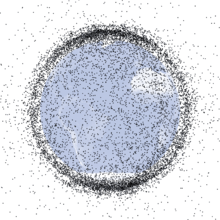
Figure 1. Debris in Earth Orbit [2]
II. LITERATURE SURVEY
Micrometeorites
As, in 1946, during the Giacobinid meteor shower, Helmut Landsberg collected several small magnetic particles that apparently were associated with the shower [4]. Instead, they would hurriedly deaccelerate and then fall to Earth unmelted. These sorts of objects, he coined the term "micro-meteorites” [2] [5].
Kessler's asteroid study
As space missions moved out from the Earth into deep space, the matter arose about the environment of the asteroid belt, which probes would have to pass through on voyages to the outer solar system. Into this void stepped
Donald Kessler The large objects in the belt would eventually be pulled onto collision courses by the actions of the other planets, notably Jupiter. When they collided, a spray of material would be ejected into a range of new orbital paths similar to the original pre-impact orbit. Since these new orbits overlapped, the objects would then be subject to collisions between each other, and since there were more of them, subsequent impacts would increase in frequency [2].
NORAD, Gabbard and Kessler
Since the earliest days of the space race, the North American Aerospace Defense Command (NORAD) has maintained a database of all known rocket launches and the various objects that reach orbit as a result – not just the satellites themselves, but the aerodynamic shields that protected them during launch, upper stage booster rockets that placed them in orbit, and in some cases, the lower stages also. The trackers that fed the database were also aware of a number of other objects in orbit, many of which were the results of on-orbit explosions [2]. Some of these were deliberately caused as a part of 1960s anti-satellite weapon (ASAT) testing, while others were the result of rocket boosters that had "blown up" in orbit as leftover fuel expanded into a gas and ruptured their tanks. Since these objects were only tracked in a haphazard way, a NORAD employee, John Gabbard, took it upon himself to keep a separate database of as many of these objects as he could. Studying the results of these explosions, a new technique for predicting the orbital paths of these products was suggested by Gabbard and Kessler [2].
A New Kessler Syndrome
After this Kessler’s analysis led to the conclusion that the problem could be categorized into three regimes. With a low enough density the addition of debris through impacts is lower than their rate of decay, and the problem does not become significant. Beyond that is a critical density where additional debris can quickly upset the system and lead to additional collisions. At a high enough density the rate of production is greater than decay rates, leading to a "cascade", or chain reaction, that quickly reduces the on-orbit population to small objects on the order of a few cm in size, making any sort of space activity potentially catastrophic [2]. This worrying possibility was called "Kessler Syndrome"[2].
III. GROWTH OF SPACE DEBRIS
According to Schefter's [8] debris amount was placed at 5,000 objects in 1981. By the late 1990s it was thought that the majority of 28,000 launched objects had already decayed and about 8,500 remained in orbit. By 2005 this had been adjusted upward to 13,000 objects, in 2006 this number had gone upto 19,000 [8]. Space debris consist of fragmentation debris, defunct space crafts, mission related debris and upper stages of launch vehicles.
IV.KNOWLEDGE OF SPACE DEBRIS LOCATION
There are two distinct phases of collision avoidance; cataloging objects and maintaining full ephemeris for each. As one would imagine, the accuracy of the ephemeris on tracked objects. Accuracy can be as good a kilometer or two for objects that are frequently tracked by radar. Less frequently tracked objects can vary from a few kilometers to tens of kilometers. The large majority of catalogued objects have accuracies in the several kilometers to tens of kilometers range. | |
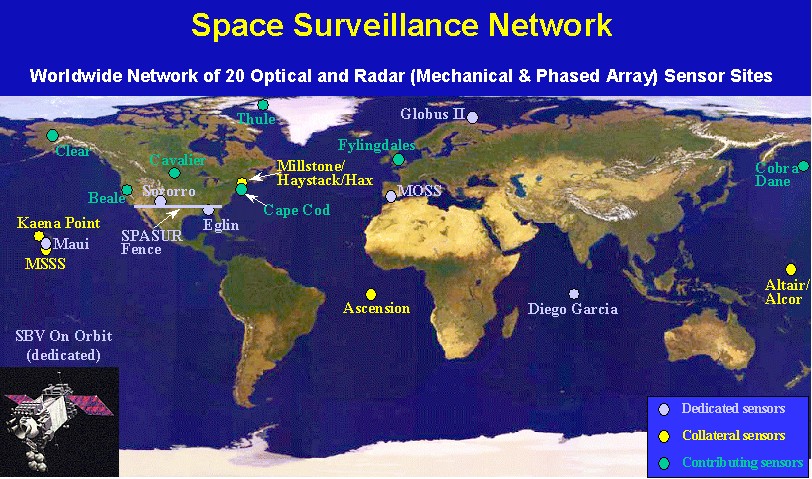 | |
|
Figure 2. Space Surveillance Network
The space control centre is the terminus for an abundant and steady flow of information from the space surveillance network. It has large and powerful computers to store “observations” which include both time tagged optical and radar measurements which sometimes include size estimates in the form of average radar red Cross section. The SCC computers and stores ephemeris for tracked objects. Owner of operational satellites may know the locations of their satellite to much better accuracy[14].
V. SOURCES OF DEBRIS
A. Big bangs in Earth orbit
The majority of space debris occurred because of explosions in higher orbits. Mission designers carry extra fuel on board in case it is unexpectedly needed. This extra fuel is stored in pressurized tanks once the rocket stage is discarded. When leaks occur sudden explosive release of pressure takes place due to each explosion thousands of small debris objects and about hundred tones of fragments are generated which are still in the orbit. This debris collides with other objects leading to creation of even more small space debris.
B. Lost Equipment
Debris is also caused during space-walks. For example Sunita Williams of STS-116 lost a camera during extra-vehicular activity(EVA) [2]. Lost equipments include garbage bag, gloves, tool kits etc. Lost equipment is one of the key sources of growing debris in space. We have to minimize this to as small as possible during the space walks.
C. Boosters
Lower stages, like the solid rocket boosters of the Space Shuttle, or like the Saturn IB stage of the Apollo program era, do not reach orbital velocities and do not add to the mass load in orbit. Upper stages, like the Inertial upper stage, start and end their productive lives in orbit. Boosters remain a serious debris problem and one of the major known impact events was due to an Ariane 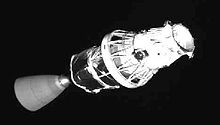
Figure 3. Booster
D. Debris from and as a weapon
One major source of debris in the past was the testing of anti-satellite weapons carried out by both the U.S. and Soviet Union in the 1960s and '70s. The NORAD element files only contained data for Soviet tests, and it was not until much later that debris from U.S. tests was identified. By the time the problem with debris was understood, widespread ASAT testing had ended. The U.S.'s only active weapon, Program 437, was shut down in 1975 [2].
VI. EFFECT OF SPACE DEBRIS ON THE OPERATION OF SPACE SYSTEM
A. Effect of large debris
Large debris refers to objects larger than 10 cm in size. Such objects lead to catastrophic collisions with space shuttles and spacecraft etc.
B. Effect of small debris
Small debris refers to objects smaller than a few millimeters in diameter which have already caused some damage to operational space systems. These impacts have had no known effect on mission success. There are some examples of damage that affect the surface of operational systems:
C. Effects of space debris on human space operations
In order to protect crews from debris during flight, operational procedures have been adopted. In the case of the Space Shuttle, the orbiter is often oriented during flight, with the tail pointed in the direction of the velocity vector. This flight orientation was adopted to protect the crew and sensitive orbiter systems from damage caused by collisions with small debris [10].
VII.SPACE DEBRIS MITIGATION MEASURES
Avoidance of debris generated under normal operation
A. Mission-related objects
Approximately 12 percent of the present catalogued space debris population consists of objects discarded during normal satellite deployment and operations. It is normally relatively easy, both technically and economically, to take mitigation measures against these objects. Solution Clamp bands and sensor covers should be retained by parent bodies, and all fragments of explosive bolts should be captured [10]. This kind of debris can be minimized by adoption of proper construction or manufacturing techniques.
B. Solid rocket motor effluents, paint and other exterior materials
Other mission-related particles may be generated unintentionally, as in the release of slag during and after the burn of solid rocket motors. The precise nature of the amount and distribution of these slag ejecta are unclear, and the improvement of solid propellant and motor insulation to minimize the released solids is difficult. Solution The application of more long-lasting paint and protective covering could be an effective remedial measure.
C. On-orbit explosions
Thirty-six percent of all resident space object break-ups are upper stages or their components that operated successfully, but were abandoned after the completion of the spacecraft delivery mission. Accidental explosions can also be caused by malfunctioning propulsion systems, overcharged batteries or explosive charges. Intentional break-ups have also been conducted. Solution Avoidance is the best solution for this problem and again proper manufacturing techniques should be adopted.
D. Reentry
Old satellites are now starting to return to Earth where they will hopefully completely be destroyed in the atmosphere or crash into unpopulated areas. However, some satellites, such as the Hubble Telescope, have no such plans for removing them from orbit. Another piece of space debris could hit these satellites, cause an explosion, and create millions of more pieces of space junk. These pieces of space debris could literally become dangerous and lethal shrapnel. Limitation Since it is not economically feasible for a spacecraft to pick up all the pieces of space junk, and then we recommend a laser that could vaporize or redirect space debris back to Earth. This laser would probably be most easily installed on the
International Space Station
E. Junkyards
Instead of tossing trash away in space, like what was recently done onboard the
International Space Station Limitation Junkyards can prove beneficial only in the case of larger space debris. This method can’t be used to serve the storage purpose for small space debris.
VIII. PROPOSED METHODS
A. Use of Decayable material in manufacturing of space machines
As we know, man-made space debris is mainly due to the defunct satellites and other space machines. The satellites and other space machines remain as it is in the space and serve no purpose after they become defunct. So they are just a kind of waste in space. That is, the satellites and other space machines should be manufactured with some decayable material instead of non-decayable material like metal, plastic etc. We mean to say that the satellites and other space machines should decay themselves in space after they become defunct. We know this is a difficult method but it can solve the problem of future space debris.
B. The Use of Nano Tubes by creating a mesh:-
In this technique we will use the nano tubes. We will create a mesh that will act as a touch panel of the touch screen cell phone. When any small or tiny particle will come on this mesh and touch it then the mesh will act as a touch panel and so that the corresponding processor or sensor will come to know the co-ordinates of it then further by using Destructive laser beam we can destroy that particle. For this type of mesh we are going to use the bunch of the Nano tubes(as per need) for creating the single thread of the Nano mesh. In this we planned to implement the technique of the RESISTIVE TOUCH PANEL. The working of this panel is just similar to the working of the resistive touch panel that presently we are working in the Touch Screen Cell phones. Whenever the particles dashed the panels the place where the particle dashed, the resistance reduces from infinity to some value. And current will flow from the point of touch between the two meshes. This is how the processor will get its coordinates and further action will be taken. For making the meshes we use the carbon nano tubes(CNT) because of its properties. CNT have been constructed from length-to-diameter ratio 132,000,000:1 as compared to other materials. CNT is the strongest material yet discovered in the terms of strength. Mainly we have to use the multiple nanotubes as MNT consist of multilayer rolled of graphite. It has good strength as compared to other materials. Moreover CNT is better than stainless steel, good electrical property which helps us in the process. 
Figure 4. Single walled CNT
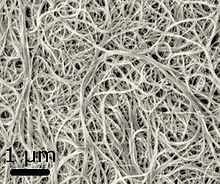
Figure 5. CNT bundles
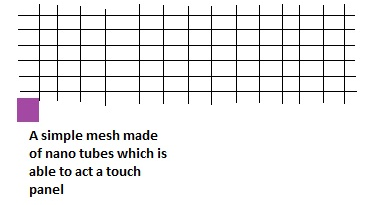 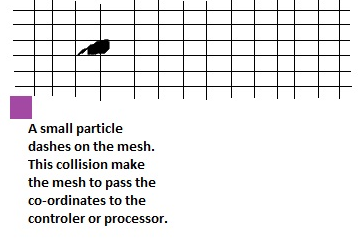 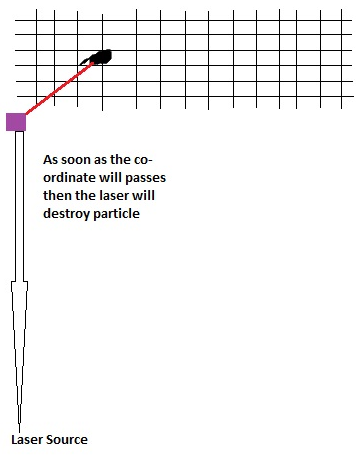 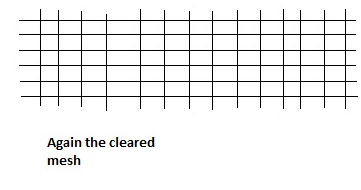
Figure 6. Explanation of the upper process
C. Use of the Nano tubes and Nano Bots for the collection of the Space Debris:
In this method also we will use a nano mesh which is made up of the nano tubes and the corresponding arrangement will be done so that the mesh will act as a touch panel same as that of the touch screen phones. When tiny particles will dash on the nano mesh then the Nano Bots which will be at the specific co-ordinates, collect the particles and store them into the garbadge storage. Today the Nano robots are used for various medical treatments. But here we will use the Nano robots as a carrier. When the tiny particles from the space will get entangled into the mesh and corresponding will be sent to the processor then the nano robots will go to the specific location. These nano robots will be programmed to collect the particles and placed it into the storage. One point here we have to note is the size of these Nano Robots won’t be at nano level it must be greater normally visible to our eyes at least because we want these robots to pick up the particles and move them to the storage. The accuracy of these robots must be that much sufficient so these robots won’t leave any particle behind. 
Figure 7. Nanobots
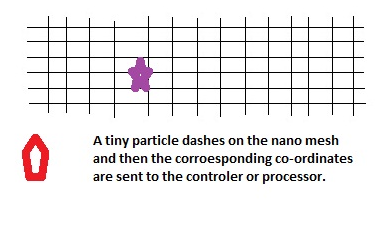 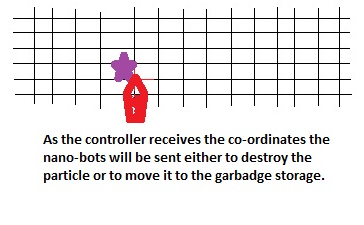 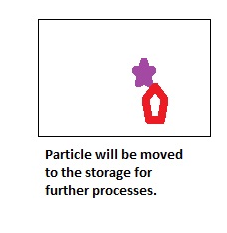 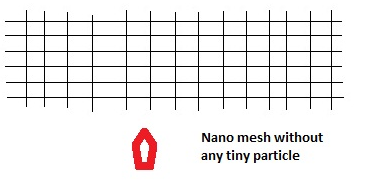
Figure 8. Explanation of the process
D. Further the space Debris can be use for the other purposes too:-
As we know that the space debris can be any tiny particle in the space. Instead of decomposing them, we can use those particles for the purpose of energy production by using the fuel cells. For this the one condition is that the particle material should be capable of forming the ionize liquid or solution which can be successfully use in the fuel cell for energy production. This is useful only for the big projects where in smallest amount of energy has also the great demand or value. 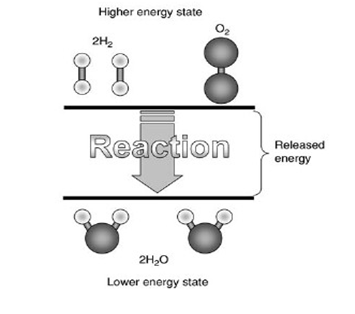
Figure 9. Working of fuel cell
E. Recycling of Space Debris
The general idea of making space structures by recycling space debris is to capture the aluminum of the upper stages, melt it, and form it into new aluminum structures, perhaps by coating the inside of inflatable balloons, to make very large structures of thin aluminum shells.
IX. CONCLUSION
Space debris has become the topic of great concern in recent years. Space debris creation can’t be stopped completely, but it can be minimized by adopting some measures. Many methods of space debris mitigation have been proposed earlier by many space experts, but some of them have limitations in them. After some modification those measures can be proved beneficial in the process of space debris mitigation. Some new methods of space debris mitigation we have proposed including: use of decayable material, nanobot and nanotube mesh technique. Moreover, we can also use it for energy generation or the making of space structures. We have already polluted our own planet earth; we should now ensure that the space is kept least polluted for our own safe exploration of the outer space and also for the safety of aliens from other planets if they happen to exist.
References:
| |
An Error Occurred
500 Can't locate object method "new" via package "Net::HTTP"

